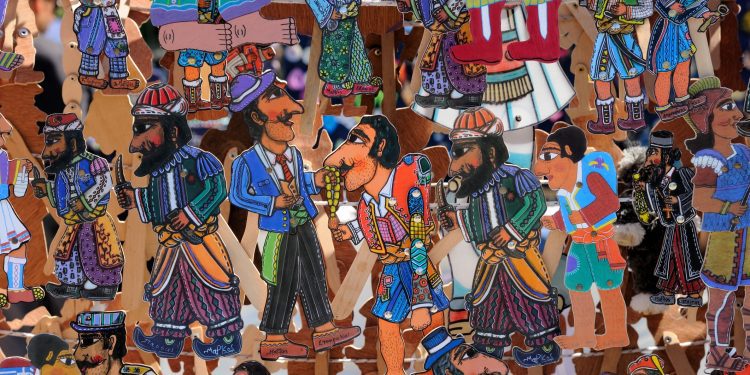Greece is a country known for its rich cultural heritage, from ancient temples and epic poetry to traditional dances and music. Yet, among these storied traditions, one art form stands out as both entertaining and deeply rooted in the Greek spirit: the shadow puppet theater of Karagiozis. This unique blend of humor, satire, and storytelling has captivated audiences for centuries, making it a cherished part of Greek cultural history. Let’s dive into the world of Karagiozis, exploring its origins, cultural significance, and where you can experience this delightful art form today.
1. The Origins of Karagiozis
The tradition of shadow puppetry in Greece traces its origins to the Ottoman period, where it was influenced by similar art forms in the Middle East, particularly Turkey. The word “Karagiozis” itself comes from the Turkish word “Karagöz,” which means “black eye.” However, while the art form shares similarities with its Turkish counterpart, it has evolved uniquely within Greece, becoming a distinct and beloved part of Greek culture.
Karagiozis made its first appearance in Greece in the early 19th century, quickly becoming a popular form of entertainment among the lower and middle classes. The character of Karagiozis, the show’s central figure, is a poor, hunchbacked man with a sharp wit and a knack for getting into trouble. He represents the common man, often poking fun at authority figures, social norms, and the challenges of everyday life in a humorous and satirical way.
2. The Characters of Karagiozis
While Karagiozis is the star of the show, the performances feature a colorful cast of characters, each representing different facets of Greek society. Some of the most notable include:
- Hadjiavatis: A friend of Karagiozis, Hadjiavatis is more cautious and often serves as a foil to Karagiozis’s impulsive and mischievous nature. He represents the voice of reason and sometimes serves as a narrator in the plays.
- The Vizier: Often depicted as the authority figure, the Vizier is a powerful, sometimes tyrannical character who Karagiozis frequently outwits. The Vizier symbolizes the ruling class or government.
- Barba Yiorgos: Karagiozis’s uncle, a loud and brash shepherd from the countryside, who brings a rustic, rural perspective to the plays. He’s fiercely loyal and often comes to Karagiozis’s aid.
- Spatharis: The noble warrior who represents the heroic ideal, often contrasted with Karagiozis’s more pragmatic and down-to-earth character.
- The Sultan’s Daughter: A beautiful and often naive character who adds elements of romance and intrigue to the stories. She is often the object of Karagiozis’s schemes or the damsel in distress.
These characters are brought to life through intricately designed shadow puppets, traditionally made from animal hide and painted with vivid colors. The puppets are manipulated behind a white screen, with a light source creating the shadows that the audience sees. The puppeteer, often a solo performer, skillfully controls multiple puppets while providing their voices, making for a dynamic and engaging performance.

3. The Themes and Stories of Karagiozis
The stories told through Karagiozis are diverse, ranging from comical everyday situations to more fantastical and adventurous tales. At the heart of many performances is the theme of the underdog—Karagiozis—using his wit, charm, and cunning to overcome obstacles, whether they be tyrannical rulers, greedy merchants, or supernatural beings.
These stories often include elements of social commentary, subtly critiquing societal norms, politics, and human nature. Despite the humor and absurdity, there’s a layer of reflection on the human condition, making Karagiozis a beloved and relatable character across generations.
Many of the plots are based on classic folk tales, historical events, or adaptations of popular stories. Over time, these performances have evolved to reflect contemporary issues, proving that Karagiozis remains a flexible and relevant art form.
4. The Cultural Significance of Karagiozis
Karagiozis holds a special place in Greek culture, not only as entertainment but as a form of social and political expression. During times of oppression or political turmoil, Karagiozis performances provided a platform for subtle resistance, allowing performers to critique those in power without direct confrontation. The clever use of humor and satire made it possible to address serious issues in a way that was accessible and engaging to the general public.
Moreover, Karagiozis has been a vital means of preserving and transmitting Greek folklore, language, and cultural values. Through its stories, audiences are reminded of the importance of resilience, cleverness, and the enduring human spirit—qualities embodied by Karagiozis himself.
5. Where to Experience Karagiozis Today
While the art of shadow puppetry has declined in popularity with the advent of modern entertainment, Karagiozis still has a devoted following in Greece. Performances can be found in cultural centers, traditional theaters, and during festivals, especially those dedicated to folk arts.
- Athens: The Greek capital is home to several venues that host Karagiozis performances, including the Spathario Shadow Theatre Museum in Marousi. This museum not only offers regular shows but also provides insight into the history and techniques of shadow puppetry.
- Festivals: Throughout the year, various festivals across Greece feature Karagiozis performances, especially those celebrating traditional Greek culture. The summer months are particularly vibrant, with outdoor performances often held in village squares or open-air theaters.
- Television and Online: Some of the classic Karagiozis performances have been adapted for television, and there are also recordings available online, making it possible to enjoy this cultural treasure from anywhere in the world.
6. The Future of Karagiozis
While modern entertainment options have overshadowed traditional art forms like Karagiozis, efforts are being made to preserve and revive this unique aspect of Greek culture. Educational programs, workshops, and cultural initiatives are introducing new generations to the art of shadow puppetry, ensuring that the legacy of Karagiozis continues to inspire and entertain.
Innovations in performance techniques and storytelling are also helping to keep the tradition alive. Some modern puppeteers are experimenting with new materials, digital technologies, and contemporary themes, blending the old with the new to attract a wider audience.
Conclusion: The Enduring Legacy of Karagiozis
Karagiozis is more than just a puppet show; it’s a reflection of the Greek spirit—resilient, clever, and always ready to laugh in the face of adversity. This ancient art form continues to captivate audiences with its unique blend of humor, satire, and storytelling. Whether you’re a lover of traditional arts, a curious traveler, or someone looking to connect with Greek culture on a deeper level, experiencing a Karagiozis performance is a must. So next time you find yourself in Greece, seek out this hidden gem of Greek folklore and let Karagiozis lead you on a journey through the shadows and into the heart of Greek culture.










